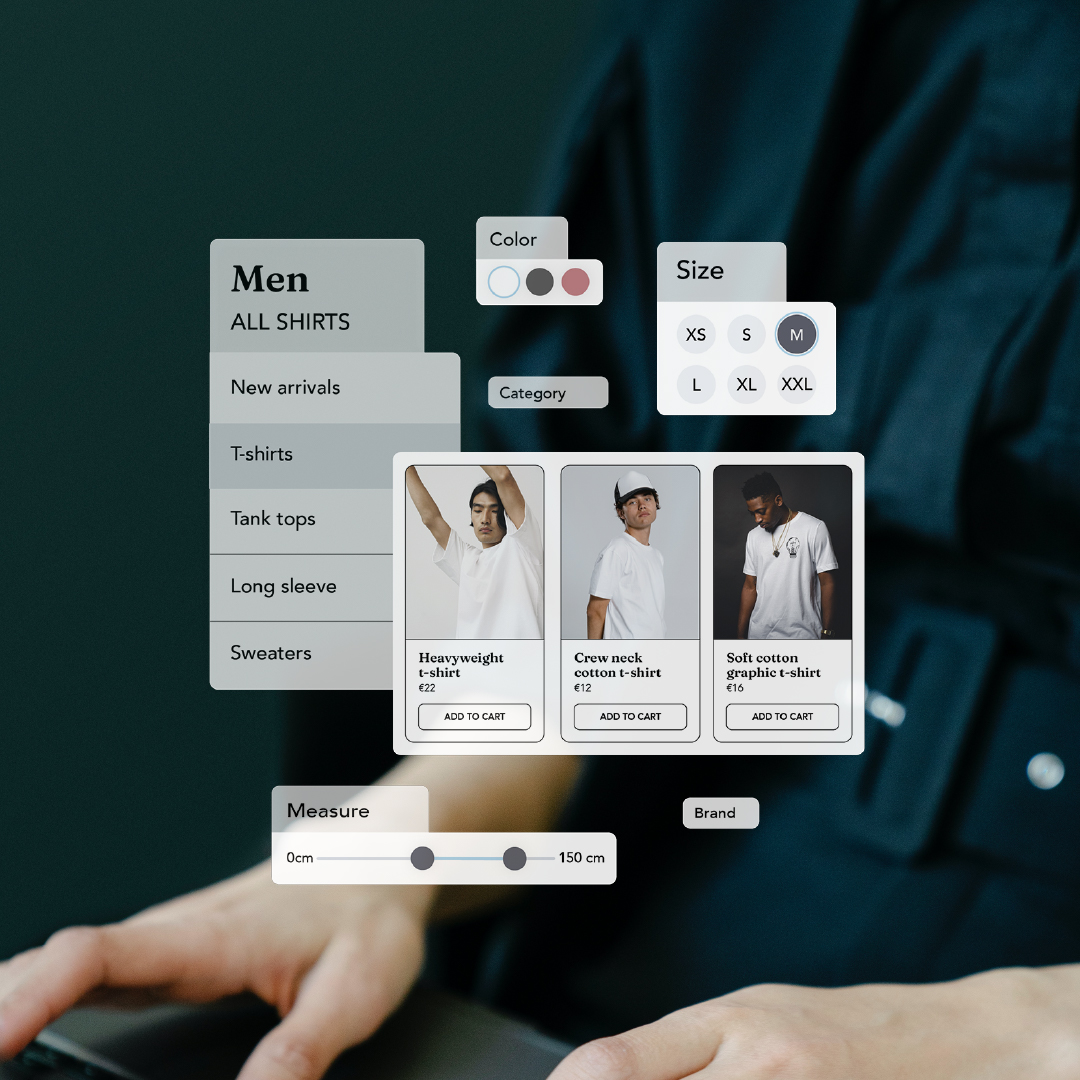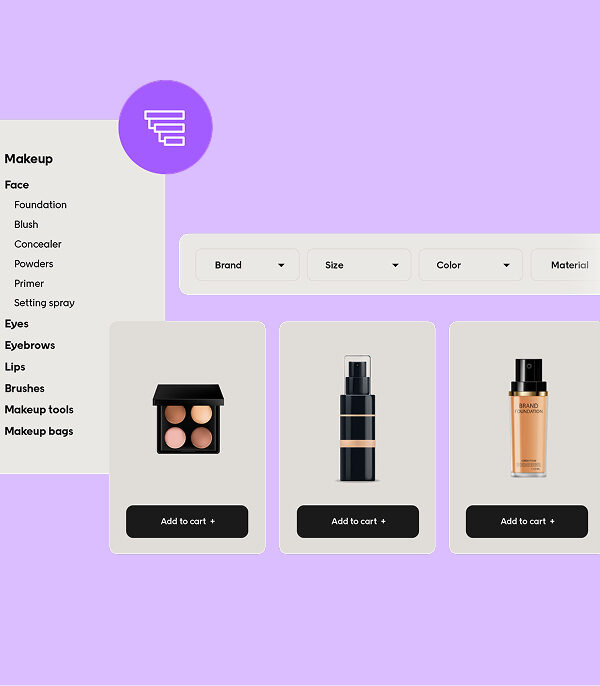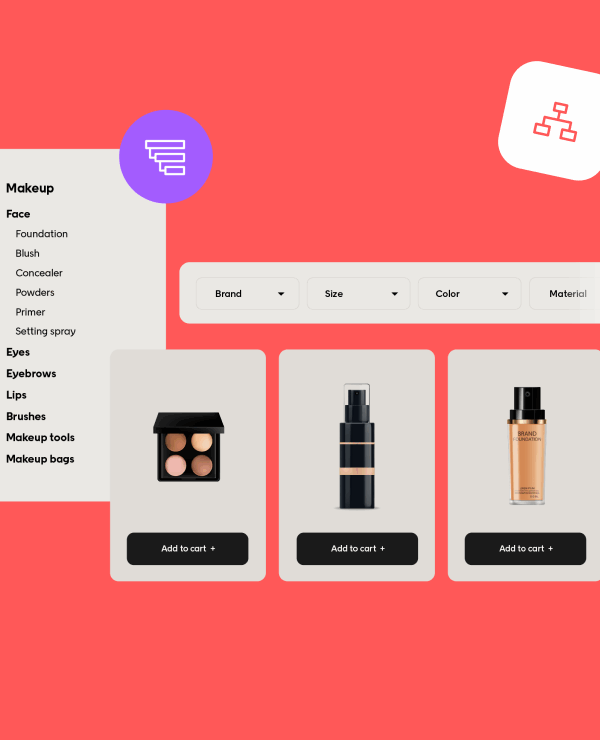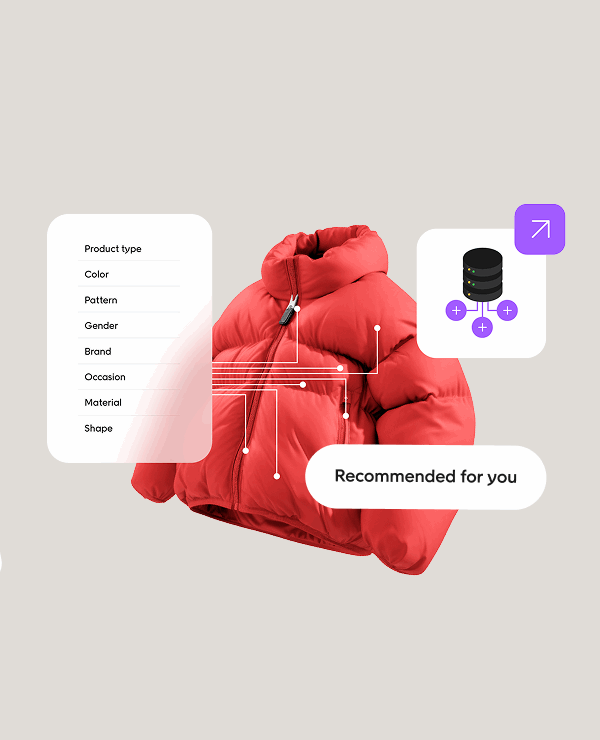E-commerce merchandising
Merchandising is all the steps you take to promote and display products in your store, making them attractive for potential customers – ranging from creating window and in-store displays and signage to choosing what to show next to each other.
E-commerce merchandising goes beyond simply listing products on a website; it requires a deep understanding of your target audience, effective presentation techniques, and the ability to leverage technology to enhance the shopping experience. Data-driven knowledge of what users are searching for and navigating to, combined with how quickly they give up in scrolling deeper into the product catalog for the right product, creates an opportunity for merchandisers but also a challenge to keep up with.
Throughout this guide, we’ll navigate various topics, including effective product listing, categorization and filtering systems, persuasive product descriptions, the importance of visual imagery, and personalized recommendations. We’ll also explore the role of data analytics in understanding customer preferences and optimizing your online merchandising strategies.
Lyko minimizes the need for manual merchandising with AI
“The solution allows us to maintain an e-commerce site offering great customer experience, where it is easy for customers to find the products or inspiration they need. It enables us to connect with our market much more customer-led, which ultimately means higher revenue.”
—Rickard Lyko, CEO at Lyko
Product data in e-commerce merchandising
Two main data groups are essential for merchandising – descriptions and inventory data.
Product descriptions data
Data describing the products helps customers understand the product qualities to decide if it matches their needs. What is needed can vary for different types of products, as some are visually driven, and others need to meet specifications:
- Description and name
- Image and videos
- Specifications: sizes, measurements of lengths, and volume
- Variations in colors, materials
Challenges with this data can be that it can come from various sources and very often needs cleaning to make sense to display to shoppers. At the same time, it often lacks in-depth data that help systematically make sense of what products belong together, how and when somebody can use them, etc. The job of a merchandiser can benefit and be made easier with processes to clean and enrich product description data.
Inventory data
For a merchandiser, understanding the lifecycle of a product is vital. You want to promote new products a little extra to gain traction, have strategies for sales, or ensure that products that are out of stock in a particular variation do not surface when it doesn’t make sense. In some vertical or international circumstances, data on how and when the product can be shipped to the customer can matter.
Data that help with this has to do with your inventory of products:
- Number of products in stock
- Newness of the product
- Shipping details
- Pricing
- Discount
Curation, campaigns, and promotions
Category listings and curated landing pages
The standard on almost all e-commerce sites today is category pages that help visitors understand the assortment available. Having this shown in a clean way that naturally adapts as you filter the assortment has come to be expected and requires minimal effort and cognitive load on the shopper’s side. Creating and maintaining these category pages sits at the heart of the e-commerce merchandiser’s tasks, ensuring the right products appear on the right page.
This includes departmental pages with specific product categories but can also be more curated mixtures of products – showing off a temporary collection or inspirational seasonal selections displayed on landing pages.
Keeping up with these pages and growing assortments can be a massive mountain to climb for merchandisers, and here is where having innovative exposure strategies and automation comes in. More about that in the section “Product life cycle, automation, and trends.”
Promoting and demoting
Ensuring that certain products get shown first or become a little more complicated to find in e-commerce terms often referred to as boost or bury. Either giving a selection of products an increase on how often or high in product listings they get shown or the opposite. This way of working is common for upcoming targeted campaigns, stock clearance of specific products, or promoting certain brands or types of products.
Burying can be for products out of season but still in stock or that the retailer carries but may want to put on something other than the top shelf.
Shared target audiences between merchandisers and marketing teams
Retailers risk working too much in silos. Where orchestrating campaigns targeting groups of customers between the online shop, retargeting campaigns, and in-store treatment when the customer comes in can be hard to achieve, it comes down to having a shared view and access to the data.
A customer data platform built with omnichannel retailers in mind and closely tied to your merchandiser toolset is a great start. When the target audience data can be shared between campaign and e-commerce promotions, ensuring you have a shared understanding of your bargain hunters and your luxury product shopper, you can be sure the right products get promoted to the right customer.
MQ Marqet increased online sales by 25%
“Since MQ had a small merchandising team, the new solution needed to provide sophisticated automation functionality that could optimize site merchandising around the clock.”
“Before implementing Voyado Elevate, there was no way of applying rules to a page, and merchandising on the MQ site meant a lot of manual and time-consuming work.”
—Petter Forsman, Digital Visual Merchandiser & Art Director at MQ
Product life cycle, automation, and trends
A product catalog is not constant – new products are introduced, some are top-selling evergreens and should always be in stock, and some are seasonal. On top of this, consumer behaviors are rapidly changing. A mention by a successful influencer can bring a micro trend up and catch a merchandiser by surprise.
An intelligent product discovery and merchandising engine will help automate this, helping orchestrate this across category pages, navigation, search, and landing pages and making sure that the right products get shown. It automatically boosts products when they are new or on sale but buries them when they go out of stock. Also, picking up on trending behaviors and promoting those trending products. In short, anywhere a customer can generate a list of products, the automation ensures the right products get the correct boost or bury – everywhere.
Algorithms and AI
In the AI age, having vast amounts of data scraped from the web with sometimes questionable sourcing and brought into large AI models is the way to go. But that is not necessarily true. Data-centric AI is the practice of “smartsizing” data to build a successful AI system using the least amount of data possible.
For a retailer and merchant, clean but rich product data becomes critical to stay relevant. This data underpins the AI models and algorithms that will provide a high-quality experience in search, navigation, and recommendations. The result will show how well you convert visitors to sales and business growth.
A product discovery engine on autopilot powered with enriched data, backed by AI and machine learning, enables merchandisers to be more efficient as the solution. Striking a perfect balance between manual control by merchandisers and automation to generate highly relevant, intent-based search results and product recommendations that elevate customer experiences and ultimately improve online retail businesses.
KICKS chose Elevate for sales generation
- 8X higher click-through rate
- 8X more add-to baskets
- 100X more sales transactions on the automated version
After a few days, Kicks abandoned the manual approach and handed sales generation to Elevate.
“We’re looking forward to doing even more testing and use of automation in the future, especially now that we’ve seen how well it can work.”
—Jenny Vesterlund, E-commerce manager at KICKS
Bringing it together to create exceptional shopping experiences
Search and navigation
According to Forrester, 43% of all visitors to a retail website go directly to the search bar. Today, most e-commerce sites offer some variant of a search function; however, the level of sophistication differs, and so does the effect these search solutions have on the overall shopping experience. The problem is that there are huge differences between what users expect from search and retailers’ product discovery capabilities.
Creating a shopping experience where the visitor effortlessly can complete and revisit search queries, see recommended next steps, and get a range of products returned on the query that matches their intentions is critical to online retail conversions and growth. Having filtering options that make sense seems easy and obvious when it works well.
But behind the scenes, a lot is going on from a merchandiser’s point of view. Be sure you serve up the right products to your visitors. It starts with product description data that capture how a product can be used and differentiated, variations, images, and what products go together. Having clean but rich product description data can significantly affect how well somebody can achieve this.
An intelligent search and navigation tool, when implemented, then provides:
- Query analysis – used for search results and product suggestions, combining basic text processing with Natural Language Processing, concept understanding, and multi-spelling corrections to capture the individual shopper’s true intent.
- Synonyms – can be added manually or as automated conceptual synonyms to extend searches of a phrase to include similar search phrases.
- Color analysis – automated color analysis of products to match the exact color closeness and distance with every search.
- Category listings – enable merchandisers to set up dynamic facets and sorting to display what is most relevant and, therefore, most likely to be purchased.
Product recommendations
Since the early 2000s, e-commerce product recommendations have been a mixture of automated recommendations driven by algorithms and highly merchandiser-curated recommendations – showing which products go well together or belong to the same product line.
Product recommendations are the act of trying to guess the next product that the customer will want or need. The recommendations are based on historical buying behaviors and product types they have interacted with or are interacting with. On an e-commerce site, you will have several different pages where various ways to recommend can be helpful.
- Category pages
- Landing pages
- Product pages
- Shopping cart page
A recommendation can show complementary products to one the customer is looking at. Or a product that goes with what is placed in the shopping cart before checkout. Depending on the page the customer is currently looking at, their logical next action will differ, so the most helpful recommendation will vary. The better the underlying product data is and the deeper the understanding of how products are related, the more targeted and personalized the automated recommendations can get.
A product discovery engine will offer a broad range for every purpose. And help keep an eye on the business rules for the merchant, making sure the products with higher prices or margins get recommended over those promoted with discounts.
Voyado Elevate – a product discovery for e-commerce growth
A product discovery engine on autopilot that shows highly relevant, intent-based search results and product recommendations on your site. It will elevate shopping experiences online and ultimately improve your business.
- Instantly relevant site search, navigation, and recommendations
- Automated merchandising and merchant control
- Leverage historical customer data & customer intent in real-time to present the right product at the right time and spot.
- Deep product understanding matching customers’ intent
- Quick, reliable, and scalable










